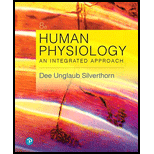
Match each of the following descriptions with the appropriate term(s):

To match: Each description with appropriate term.
Answer to Problem 1RQ
Correct Answer:
| a. Chyme is produced here | 2.stomach |
| b. Organ where most digestion occurs | 3.small intestine |
| c. Initial section of small intestine | 4.duodenum |
| d. This adds exocrine secretions to duodenum via a duct |
7.pancreas, 10.liver |
| e. Sphincter between stomach and intestine | 8.pylorus |
| f. Enzymes produced here |
2.stomach, 3.Small intestine, 7.Pancreas |
| g. Distension of its walls triggers the defecation reflex | 9.rectum |
Explanation of Solution
a. Chyme is produced here- 2. stomach
Chyme is mixture of partly digested food and stomach fluids. The food comes through the esophagus and reaches to stomach. The secretions from the digestive glands reach the stomach, and they form a mixture called chyme.
b. Organ where most digestion occurs- 3. small intestine
The small intestine is the site at which most of the digestion occurs. This is because small intestine provides larger surface area due to the presence of villi.
c. Initial section of small intestine- 4. duodenum
The small intestine is divided into three sections, namely duodenum, jejunum, and ileum. The duodenum is the initial section of the small intestine.
d. This adds exocrine secretions to duodenum via a duct- 7. Pancreas and 10. liver
Pancreas and liver are two accessory glandular organs. The pancreas secretes pancreatic juices and the liver secretes bile. Their secretions enter into the duodenum via ducts.
e. Sphincter between stomach and intestine- 8. pylorus
The pylorus is present between the stomach and small intestine; it acts as a gatekeeper. The movement of the pylorus is guarded by the pyloric valve. The valve is a thickened band of smooth muscle.
f. Enzymes produced here- 2. stomach, 3. small intestine, 7. pancreas
Enzymes are the proteins that break food into an absorbable form. The stomach produces two enzymes, gastric lipase and pepsinogen. The small intestine produces two enzymes, maltase, and peptidases. The pancreas produces proteolytic enzymes such as trypsin and chymotrypsin.
g. Distension of its walls triggers the defecation reflex- 9. rectum
The rectum is the end part of the large intestine that stores undigested food for some time. When the volume reaches up to the level, the defecation reflex occurs. This removes the undigested food from the body in the form of feces.
Want to see more full solutions like this?
Chapter 21 Solutions
Human Physiology: An Integrated Approach (8th Edition)
- Can you described the image? Can you explain the question as well their answer and how to get to an answer to an problem like this?arrow_forwardglg 112 mid unit assignment Identifying melting processesarrow_forwardGive only the mode of inheritance consistent with all three pedigrees and only two reasons that support this, nothing more, (it shouldn't take too long)arrow_forward
- Oarrow_forwardDescribe the principle of homeostasis.arrow_forwardExplain how the hormones of the glands listed below travel around the body to target organs and tissues : Pituitary gland Hypothalamus Thyroid Parathyroid Adrenal Pineal Pancreas(islets of langerhans) Gonads (testes and ovaries) Placentaarrow_forward
- What are the functions of the hormones produced in the glands listed below: Pituitary gland Hypothalamus Thyroid Parathyroid Adrenal Pineal Pancreas(islets of langerhans) Gonads (testes and ovaries) Placentaarrow_forwardDescribe the hormones produced in the glands listed below: Pituitary gland Hypothalamus Thyroid Parathyroid Adrenal Pineal Pancreas(islets of langerhans) Gonads (testes and ovaries) Placentaarrow_forwardPlease help me calculate drug dosage from the following information: Patient weight: 35 pounds, so 15.9 kilograms (got this by dividing 35 pounds by 2.2 kilograms) Drug dose: 0.05mg/kg Drug concentration: 2mg/mLarrow_forward
- A 25-year-old woman presents to the emergency department with a 2-day history of fever, chills, severe headache, and confusion. She recently returned from a trip to sub-Saharan Africa, where she did not take malaria prophylaxis. On examination, she is febrile (39.8°C/103.6°F) and hypotensive. Laboratory studies reveal hemoglobin of 8.0 g/dL, platelet count of 50,000/μL, and evidence of hemoglobinuria. A peripheral blood smear shows ring forms and banana-shaped gametocytes. Which of the following Plasmodium species is most likely responsible for her severe symptoms? A. Plasmodium vivax B. Plasmodium ovale C. Plasmodium malariae D. Plasmodium falciparumarrow_forwardStandard Concentration (caffeine) mg/L Absorbance Reading 10 0.322 20 0.697 40 1.535 60 2.520 80 3.100arrow_forwardPlease draw in the missing answer, thank youarrow_forward
 Human Biology (MindTap Course List)BiologyISBN:9781305112100Author:Cecie Starr, Beverly McMillanPublisher:Cengage Learning
Human Biology (MindTap Course List)BiologyISBN:9781305112100Author:Cecie Starr, Beverly McMillanPublisher:Cengage Learning- Health Safety And Nutrition F/Young ChildHealth & NutritionISBN:9781305144767Author:MAROTZPublisher:Cengage





